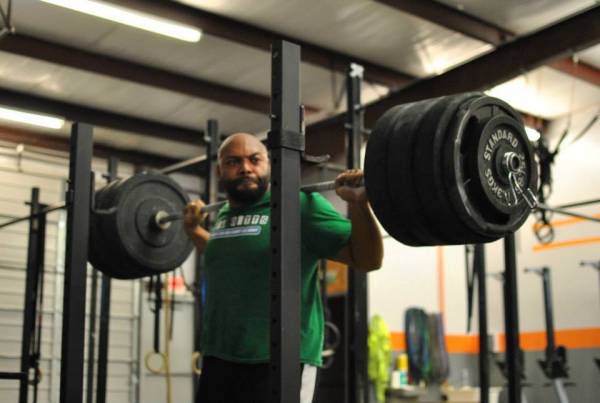Back in 2002 I was one year into altering my professional path. I had struggled in a 100% one-on-one private training model and decided to move some of my focus to group training. One day while surfing around the Internet I found World Class Fitness in 100 Words. I found it fascinating, and when the online store failed to take my subscription order, I immediately call the phone number listed on the CrossFit website.
Within a year I was standing in a 1,200-square-foot gym in Santa Cruz, California with nine other fitness pioneers learning about CrossFit from the creators, Greg and Lauren Glassman. I was excited to put some of my new knowledge to work when I returned home, but quickly discovered that most all of my clients failed to demonstrate the strength necessary to executed most of the classics CrossFit workouts.
At the invitation of Greg and Lauren, I made several trips back to Santa Cruz. (This was an enjoyable and pioneering time in my career and life, but that’s another story.) While there, I observed that the best athletes and those finishing near the top of the leaderboard rankings also demonstrated better absolute and relative strength. For instance, after performing several high intensity METCONs for the certification groups, I watched Greg Amundson perform several singles of thrusters with 125kg while wearing running shoes. Strong guy!
Suddenly, it was clear as a bell. My athletes simply lacked the strength necessary to properly execute the workout of the day (WOD). So I began implementing dedicated strength training along with the CrossFit template design. As a result, I noticed that my clients’ loading moved closer to what was prescribed. That fall I was retained by one of the city’s best high school basketball coaches. Using this same approach, the basketball players’ strength improvements continued throughout the season.
With this the Max Effort Black Box (MEBB) concept was hatched.
The Components of the MEBB
MAXIMUM EFFORT (ME): A cornerstone to this approach is a barbell session where the athlete works with a load near his or her maximum. This will typically fall in the 90%+ range. Reps will range from 1-5. Max effort does not necessarily mean vein bursting or stroke inducing. This is typically coached as “your best effort” for the day.
MOVEMENT ROTATION: Taking a page from Joe Kenn, movement pools are divided into total body (T), lower body (L) and upper body (U):
TOTAL BODY (T): These movements include a combination of lower body and upper body. Typically ground-based and including a transfer of energy from lower to upper. These would be Olympic clean variations, snatch variations, push presses, and jerks. Deadlifts can be placed in this movement pool.
LOWER BODY (L): These movements include movements below the waist. Think squats (front and back), pistols, and trap bar deadlifts.
UPPER BODY (U): Anything above the waist. These include the press (vertical, horizontal, and incline), pull ups, push ups (difficult to overload), handstand push ups, and dips.
The first day of strength is a total body move, the next strength day is a lower body movement, and then finally an upper body movement. What occurs is a rotation of these ME days. On the first ME day, we perform a total body movement; on the second ME day, a lower body movement; and finally on the third ME day, an upper body movement.

There are three week and two week rotations with the T, L, and U movement tiers, moving from an introductory week to an intensification week of singles. If you are a novice strength trainee, then start with the three-week repetition rotation. You should also have a small movement pool and focus on squats, presses, and the power versions of the Olympic movements.
A three-week rotation reps looks like this:
Week 1: 5-5-5-5-5
Week 2: 3-3-3-3-3
Week 3: 1-1-1-1-1
The two-week rotation repetition works well with those who have been exposed to strength work:
Week 1: 5-5-5-3-3-3
Week 2: 3-3-3-1-1-1*
(*Total body movements stay with the 3-3-3-1-1-1 rep scheme to maintain rep quality when performing total body movement.)
Here is an example of a two-week movement pool rotation:
Day 1 – CrossFit Workout
Day 2 – Hang Power Clean (T) 3-3-3-1-1-1
Day 3 – CrossFit Workout
Day 4 – REST
Day 5 – CrossFit Workout
Day 6 – Back Squat (5-5-5-3-3-3)
Day 7 – CrossFit Workout
Day 8 – REST
Day 9 – CrossFit Workout
Day 10 – Supine Bench (U) (5-5-5-3-3-3)
Day 11 – CrossFit Workout
Day 12 – Hang Power Clean (T) 3-3-3-1-1-1
Day 13 – CrossFit Workout
Day 14 – REST
Day 15 – CrossFit Workout
Day 16 – Back Squat (L) 3-3-3-1-1-1
Day 17 – CrossFit Workout
Day 18 – REST
Day 19 – CrossFit Workout
Day 20 – Supine Bench (U) 3-3-3-1-1-1
The construction and selection of CrossFit workouts should “fit nicely” into the rotation of strength moves and should vary from brief to longer time requirements. Experience has demonstrated that brief challenges with a bias towards power produce a superior return on investment.
Photos courtesy of CrossFit Impulse.






